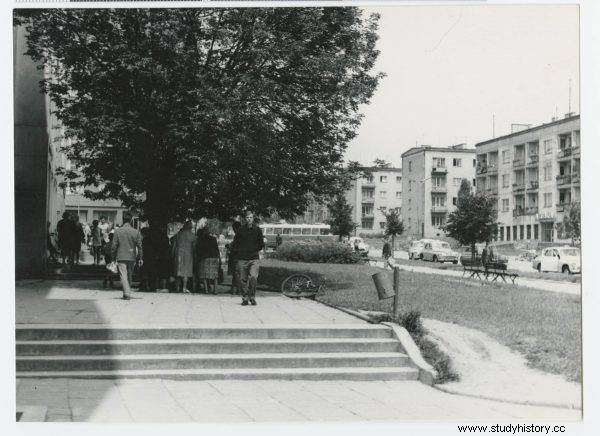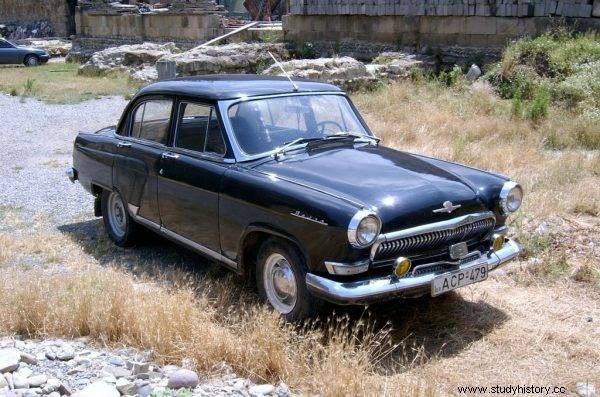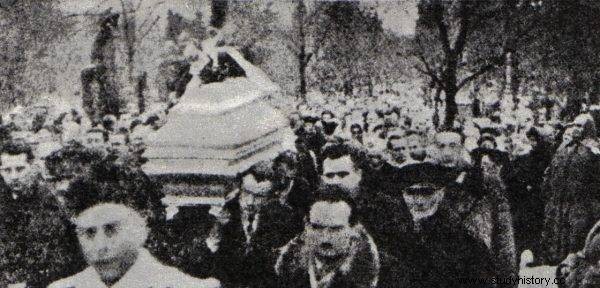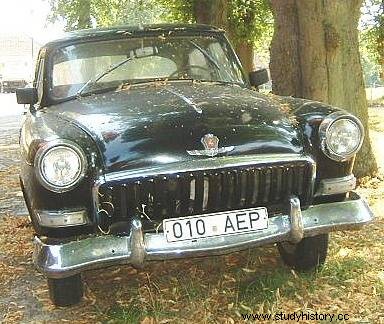She roamed the streets of Polish towns and villages. Mostly after dark. Her driver, whoever he was, had no good intentions, especially when it came to the children. Meetings with her often ended tragically. Is the story of the Black Volga and the accompanying kidnappings and even murders true? Why was it established and so deeply rooted in Polish - and not only - society?
The 60s and 70s of the last century. In Polish homes, schools, parks, playgrounds and other quite eagerly visited places, adults seem to look more closely at children. They warn. They shake a finger. They encourage children not to talk to strangers and not accept any gifts from them. God forbid, they did not go away with strangers in an unknown direction. What's weird about that? Probably nothing. After all, such behavior is natural. In fact, it even testifies to the parent's care and commitment. Sixty years ago, however, it had an additional stimulus with the hallmarks of social psychosis. Psychosis, which had a specific color and brand - Black Volga.
Who drove the Volga?
Over the years, a forest of legends has sprung up around the car circling the streets of Polish cities - usually after dark -. His driver, sometimes with companions, was supposed to kidnap children. It is not known who he was and who traveled with him. People said that it was probably the Jews who dragged the youngest into a car, transported them to a secluded place and committed murders. They were to use the blood of Christian children obtained in this way to make matzo - bread eaten during the Passover holiday. This was nonsense, in Judaism blood is considered something unclean and - however it sounds - inevitable. But if an acquaintance, brother-in-law, neighbor said so, it had to be true. So the rumor was passed on.

Over the years, a forest of legends has sprung up around the car circling the streets of Polish cities - usually after dark -
Another version spoke of the Germans. The scheme was supposed to be similar:a black Volga would drive up to a lonely little boy, someone pulled him inside and then took him away. Most often across the western border, where his blood was supposed to help the rich fight leukemia . Satanists, eager to find victims for the next ritual, were also supposed to be sitting behind the wheel of the car. It was also not uncommon to say that KGB or SB agents trafficking in human organs were behind the disappearances of children. The dark Volga was to be ruled by priests, nuns, monks, vampires, and even the devil himself.
Whether the story had arms and legs or was irrational, its ending was usually the same:the kidnapped was dying. This is why she frightened the children and taught them to be careful. For many parents, it has become an educational tool. Brutal and not very sophisticated, but effective.
An urban legend?
The Volga cars, produced in the USSR since 1956, were considered quite luxurious cars. The spacious interior, attractive appearance and quite rich furnishings meant that there was no shortage of people willing to buy them - those from the upper class. These cars were also used by services and party dignitaries, which is why the average Kowalski did not always associate them well. The car that had been seen in child abduction sites had curtains in the windows, a white stripe on the door, it was riding on white tires and had no license plates . In fact, in every word of mouth describing appearance, something else was added, which in turn created more absurdities.

The Volga cars, produced in the USSR since 1956, were considered quite luxurious
Today, the stories about the Black Volga are classified as "urban legends". According to Mark Bauber, they are "contemporary urban myths or macro gossip, tales of contemporary folklore that can be disseminated by traditional methods such as word of mouth or modern methods such as e-mail, fax and the Internet." They are often based on fears characteristic of a given period, but with time they evolve, reflecting the specificity of subsequent eras . On the other hand, the old saying goes, there is a grain of truth in every legend. Each of them has its source somewhere. In order to find the beginnings of the Black-Volga hysteria, we have to go back to the 1950s, to the actual events - the series of disappearances of children in Poland.
The three vanished like a stone into water
The year 1956. On a sunny day in July, Barbara Sieśkiewicz went to her friend, to Baranówek. She was accompanied by her four-year-old daughter Mirka, eight-year-old son Marek and his eleven-year-old friend, Janusz Pacyna. The children were obviously bored with the conversation of the women. They ate a few cherries and went outside. After thirty minutes, Barbara said goodbye to her friend and left the house. In the yard, she was horrified to say that three kids had disappeared . She began searching. First alone, then her husband and neighbors helped her. The several-hour-long operation ended in failure. Mirka, Marek and Janusz were lost. On the evening of the same day, she was reported missing to the police.
Officers launched one of the largest search operations in history. They researched every thread and involved the local community. The first information, often anonymous, began to flow out on command. And so it turned out that a stranger was seen in the area, who accosted passers-by, asking for a letter to be delivered to one of the houses . The policemen quickly tracked him down, but it turned out to be the wrong track. The man - a recidivist thief by the way - wanted to convey the message to his mistress, but he did not have the courage to do it on his own. However, he had nothing to do with the disappearance of the children.

Mirka, Marek and Janusz went missing in Baranówek, today a district of Kielce
The case gained media attention. The authorities claimed that it had a political dimension and could cause social unrest, the more so as a rumor had spread in the area that the kidnapping of the children was a Jewish revenge for the Kielce pogrom. So a Jewish thread appeared in the case, so much later "more attractive".
Security Office officers were involved in the work and determined that a navy blue car was seen in the area, with three children in it. Some time later it turned out that he belonged to a certain Greek, but he had nothing to do with it either. Nevertheless, the work continued, because the voivodship headquarters received a denunciation every now and then. At one point, the search group analyzed as many as 70 hypotheses! Almost everyone was the suspect, including the children's parents.
More disappearances
January 1957. From the Secondary School of General Education st. Augustine, Bohdan Piasecki, son of Bolesław, the leader of the pre-war Falanga and the founder of the Pax Association, disappears in Warsaw. According to the accounts of witnesses, a 15-year-old man approached the street, showed a document and invited him to a black car standing nearby, in which his companion was waiting. It was then that the boy's friends saw him for the last time.
The search has begun. The kidnappers contacted the family and demanded a ransom:$ 4,000 and PLN 100,000 . The money was to be donated by Father Mieczysław Suława, and later by Ryszard Reiff. Unfortunately, subsequent instructions to change the place where the ransom was handed over eventually led to a dead end. Contact with potential hijackers has been cut off and Bohdan has still not been found.

The funeral of Bohdan Piasecki
A few days passed, and the news of the next disappearance of the child spread across Poland. In Krakow, at Jagiellońska Street, Mrs. Ogońska left a three-year-old Marek in a pram. The woman entered the hairdressing salon for a moment. As she left it, she noticed that the stroller and son were gone. Alarmed policemen immediately began to look for him. A few hours later, a trolley was found at the gate at Floriańska Street. It was empty.
September 1957. Wanda Kozak, the wife of a well-to-do businessman, Zdzisław, worried about the long absence of her daughter Basia, ran into the corridor of one of the police stations in Poznań. At the same time, the phone rang in her house. The housekeeper picked him up. A stranger asked about Wanda, he wanted to talk about her daughter . When the woman said that she was reporting her missing to the services, the voice on the other end announced that she would call later. However, he never did.
Years passed. More minors have been reported missing in various parts of the country. Articles about the gang kidnapping children appeared in the press. Or about serial kidnappers, such as Mieczysław Hała, who abducted the youngest and kept them in her home. In 1965 in Warsaw, two women claiming to be distant relatives of a certain Hencel kidnapped his daughter Lilianna. Thanks to the vigilance of two students, the police knew that the kidnappers were moving in a black Volga. They were located quickly.
What happened to the children?
Mirka, Marek and Janusz were found by a man carrying sand to the embankment at one of the construction sites in Kielce. It was February 1957 when he noticed the baby's leg. After arriving and digging the area, the bodies of the three wanted were found. It turned out that the playing children decided to dig a tunnel in the sand. The structure collapsed, crushing children with a weight of several tons, just two hundred meters from where they were last seen.
On December 8, 1958, plumbers checking the sanitary facilities in the basement of the house at al. Świerczewskiego 82a in Warsaw, they found the body of Bohdan Piasecki. Most likely, the boy was murdered on the day of the kidnapping. The murderers hit him in the head with a blunt instrument and pierced his chest with a dagger . To date, it has not been established who is responsible for this crime.
The story of Marek Ogoński, who was brought to the militia by a 16-year-old girl after three days, happily ended. She claimed to have found the boy. The officers assumed that she was behind his kidnapping.

On December 8, 1958, plumbers checking the sanitary facilities in the basement of the house at al. Świerczewskiego 82a in Warsaw, they found the body of Bohdan Piasecki
Basia Kozak was found on the bank of the Warta River. She was dead. Investigators assumed from the beginning that someone who knew her family was responsible for her death. Even a suspect has been selected. It was her aunt's brother, a certain Zdzisław Z. Already at the first interrogation, the man pleaded guilty . He had financial problems, and the kidnapping of the girl and the subsequent extortion of a ransom were to repair his budget.
Little Liliana was found in the company of women who had previously claimed to be Hencel's extended family. The women kidnapped the child, because one of them, Halina Szlegiel, wanted to have a healthy daughter, because her child was born blind.
The legend lives forever
Several kidnappings had one thing in common:a dark car that children were getting into. Although he only actually appeared in the case of Lilianna's abduction, the public knew theirs. With almost every reported missing child, one of the witnesses testified that they had seen the Black Volga . No matter whether in Silesia or Pomerania. The car was supposed to travel around the country, and people added more nonsense stories to its legend. Hence the versions about curtains, white tires, rich Germans, etc.

Almost with every reported missing child, one of the witnesses testified that they saw the Black Volga.
It is worth noting that this legend has crossed the borders of Poland. It spread, for example in Russia, Belarus, China and Ukraine . Moreover, even films were made from these stories. Whatever the wording, the Black Volga had a plus point:the children, who had been familiar with any version of its story before, were much, much more alert.
The People's Republic of Poland collapsed and the myth of the mysterious car survived. In a slightly changed version. At the end of the 20th century and the beginning of the 21st century, there was talk of a dark BMW whose driver hunts for the youngest. In 1999, in Ostrów Wielkopolski, a town with a population of 76,000, panic was caused by a rumor about Satan who drives a black limousine and kills him by asking about the time. In 2021, Facebook users massively shared information about the white bus to which children were dragged. Although the police denied the rumors, many Poles could not be persuaded. Well, time flies and the legend is still alive.
Bibliography:
- http://www.mojasocjologia.pl/legendy-miejskie/ [access:March 25, 2022]
- https://wyborcza.pl/7,75410,1853428.html [access:March 25, 2022]
- https://www.magazyndetektyw.pl/czarna-wolga-byla-bohaterka-najslynniejszej-legendy-prl-u/ [access:March 25, 2022]
- https://epoznan.pl/news-news-69112-ewa_tylman_to_nie_pierwsza_zaginiona_ktorej_zwloki_odnaleziono_w_warcie [accessed:March 25, 2022]
- "Volga" from the Volga [in:] Przekrój, No. 545 (38/1955)
- https://grodzisk.naszemiasto.pl/bialy-bus-krazy-po-okolicy-i-zotykia-dzieci-policja/ar/c8-5046077 [access:March 25, 2022]
- Semczuk, Black Volga. Criminal history of the People's Republic of Poland , Krakow 2013.
